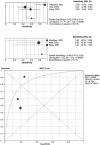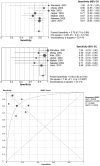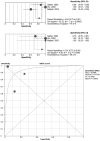Meta-analysis of the diagnostic performance of [18F]FDG-PET and PET/CT in renal cell carcinoma
- PMID: 23108238
- PMCID: PMC3483599
- DOI: 10.1102/1470-7330.2012.0042
Meta-analysis of the diagnostic performance of [18F]FDG-PET and PET/CT in renal cell carcinoma
Abstract
Objectives: Positron emission tomography (PET) using fluorodeoxyglucose (FDG) is useful for restaging renal cell carcinoma (RCC) and detecting metastatic diseases but is less satisfactory for detecting primary disease. We evaluated whether the integration of computed tomography (CT) scans with the PET system could increase the applicability of FDG-PET for RCC.
Methods: The MEDLINE databases were searched for relevant studies published since 2001. Two reviewers independently assessed the methodological quality of each study identified. We then performed a meta-analysis of the sensitivity and specificity of FDG-PET findings as reported in all the selected studies.
Results: Fourteen studies were eligible for inclusion. The pooled sensitivity and specificity of FDG-PET were 62% and 88% respectively, for renal lesions. For detecting extra-renal lesions, the pooled sensitivity and specificity of FDG-PET were 79% and 90%, respectively, based on the scans, and 84% and 91% based on the lesions. The use of a hybrid FDG-PET/CT to detect extra-renal lesions increased the pooled sensitivity and specificity to 91% and 88%, respectively, with good consistency.
Conclusions: For RCC, combining the FDG-PET and CT systems is helpful for detecting extra-renal metastasis rather than renal lesions. The hybrid PET/CT system has comparable sensitivity and specificity with PET in detecting extra-renal lesions of RCC.
Advances in knowledge: The FDG-PET and PET/CT systems are both useful for detecting extra-renal metastasis in renal cell carcinoma.
Figures




References
-
- Frank IN, Graham SD, Nabors WL. Urologic and male genital cancers. In: Holleb AI, Fink DJ, Murphy GP, editors. Clinical oncology. Atlanta, GA: American Cancer Society; 1991. pp. 283–287.
-
- Hustinx R, Benard F, Alavi A. Whole-body FDG-PET imaging in the management of patients with cancer. Semin Nucl Med. 2002;32:35–46. PMid:11839068. - PubMed
-
- Tavani A, La Vecchia C. Epidemiology of renal-cell carcinoma. J Nephrol. 1997;10:93–106. PMid:9238616. - PubMed
